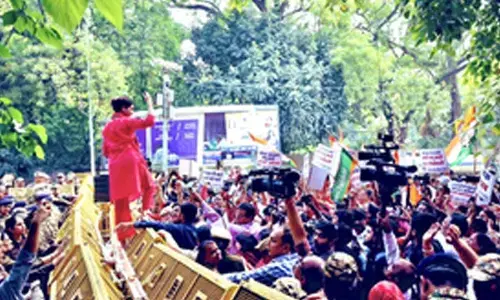Steep fall in cotton cultivation due to drought, pest attack

The crop acreage and production started dwindling as the scientists warned against cultivating the crop in red soils as it is found to be unsuitable. Only black soils are said to be conducive for cotton cultivation.
Anantapur: Cotton production and acreage which was 2.78 lakh hectares in Kurnool and 70,976 hectares in Anantapur in the Rayalaseema at one time is now on a downward trend due to a pink bollworm plague damaging the crop and adversely affecting its yield.
The crop acreage and production started dwindling as the scientists warned against cultivating the crop in red soils as it is found to be unsuitable. Only black soils are said to be conducive for cotton cultivation.
In the past, the extent of cotton cultivation was in a mere 2,000 hectares in the district. After the introduction of Bt cotton, cotton cultivation saw a revolution and the acreage gradually increased in the district from a mere 2,000 hectares to 70,976 hectares in 2014-15.
Agriculture scientist John Sudheer told The Hans India that 2015-16 and 2016-17 years were very bad for cotton due to the severe drought conditions on one hand and the pest called bollworm which struck the plants on the other hand. As a result, the cultivation of cotton fell to 22,000 hectares.
The best year for cotton was in 2014-15 when farmers went for the drought resistant crop in both red and black soils and registering the highest coverage of 70,976 hectares in Anantapur and 2.78 lakh hectares in Kurnool.
The farmers earned handsomely at the rate of Rs 5,000 per quintal and even if a minimum four quintals were produced in a single acre, they would earn Rs 20,000 per acre.
However, the decline started from 2015-16 year when the acreage dropped down to 66,000 hectares and in the subsequent year to 22,000 hectares in Anantapur, which is a steep fall from the 2014-15 figures.
In a double crop system also, cotton is being preferred due to uncertain monsoon conditions.Crop can withstand the dry spell for 30-40 days less post harvest operations. Compared to chillies and tobacco, it is less risky and more remunerative.
Distinct variation in productivity levels are also observed in different regions like coastal area recording high productivity levels compared to Rayalaseema and Telangana.
It is clear that cotton cultivation is non-remunerative in red soils of Telangana and Rayalaseema in Andhra Pradesh. The adverse factors for the crop include vagaries of monsoon, increased cost of cultivation, cultivation of cotton in red soils, lack of high yielding and multiple insect and disease resistant varieties besides lack of location specific agro techniques.
Imbalanced use of fertilisers, heavy incidence of suckling pests mainly leafhopper, development of resistance in sucking pests, lack of antibiotic tolerant Bt cotton hybrids and increased cost of cultivation due to high picking cost are the major problems dogging farmers particularly in Anantapur and the parts of Rayalaseema.
John Sudheer says that development of high yielding and multitude pest and disease resistant genotypes, development antibiotic stress, high yielding and early maturing varieties and hybrids with desirable fibre qualities are some of the future thrust areas for research.
Farmers feel that emphasis should be on the development of Bt cotton varieties and hybrids and on the establishment of a cotton research institute in Rayalaseema.

















